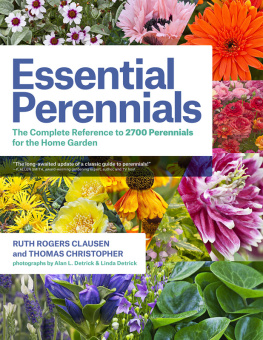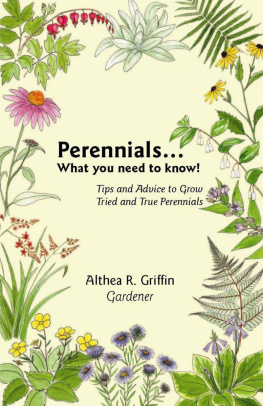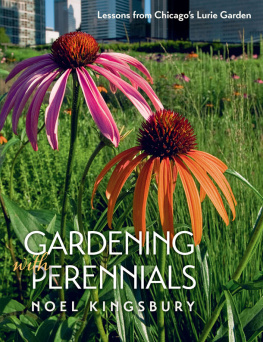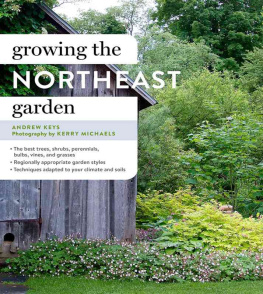Essential Perennials
The Complete Reference to 2700 Perennials for the Home Garden
RUTH ROGERS CLAUSEN and THOMAS CHRISTOPHER
photographs by Alan L. Detrick & Linda Detrick
Timber Press
Portland | London
Acknowledgments
We owe a great debt to all the nursery professionals who generously shared plants and knowledge with us during the writing of this book. Gardeners are a passionate group; many have shared with us their opinions about the superiority or otherwise of recent plant introductions, and we thank them for that. We thank our editor, Tom Fischer of Timber Press, an extraordinary gardener in his own right, who kept us abreast of changes in botanical nomenclature and showed exceptional patience in helping us to bring this project to completion. Thanks go to Michael Dempsey for his invaluable editorial assistance. Finally, we thank Alan and Linda Detrick for their friendship, encouragement, perseverance, and most of all for their superb photography.
Copyright 2014 by Ruth Rogers Clausen and Thomas Christopher.
Photography credits on . All rights reserved.
Published in 2014 by Timber Press, Inc.
The Haseltine Building | 6a Lonsdale Road |
133 S.W. Second Avenue, Suite 450 | London NW6 6RD |
Portland, Oregon 97204-3527 | timberpress.co.uk |
timberpress.com |
Cover and text design by Laken Wright
Library of Congress Cataloging-in-Publication Data
Clausen, Ruth Rogers, 1938
Essential perennials: the complete reference to 2700 perennials for the home garden/Ruth Rogers
Clausen and Thomas Christopher; photographs by Alan L. Detrick and Linda Detrick.First edition.
pages cm
Includes index.
ISBN 978-1-60469-672-1
1. PerennialsHandbooks, manuals, etc. I. Christopher, Thomas. II. Title.
SB434.C57 2015
635.932dc23
2014020896
A catalog record for this book is also available from the British Library.
For passionate, experienced gardeners, and those who are just discovering the joy of gardening with perennials.
In memory of Nicolas H. Ekstrom, our friend and colleague.
Contents
Introduction

Ornamental grasses and asters extend the fall season at Chanticleer Garden in Pennsylvania.
ANY EXPERIENCED GARDENER KNOWS that perennialsherbaceous (more or less non-woody) plants that go dormant in the fall and then return in the springare the main fabric of an ornamental garden. Trees and shrubs provide architecture, annuals may embroider the design, but its the perennials that supply the enduring keynotes of texture, the calculated sequences and rhythms of colors and forms. Perennials dominate through persistence. If youve chosen your plants well, once you lay down a theme in perennials, it returns year after year, becoming the framework around which you arrange other plants and furnishings.
This is why selecting your perennials wisely is such an important processthe decisions you make can and should have long-lasting repercussions. The process of selection is challenging. Indeed, because of our good fortune, its more challenging, or at least more complicated, than ever before. In the last 30 years the American gardener has moved from a situation of perennial famine to one of feast. A generation ago we had access to only a relative handful of old standbys. Since then, however, enterprising breeders, growers, nurseries, and plant hunters have introduced tens of thousands of new species and cultivars to the North American market. Whats more, thanks to the Internet, virtually all these introductions are available for a click and some cash, no matter where you live.
There are obvious advantages to this opening of the horticultural floodgates. Plant collectors can satisfy their lust for novelty without ever leaving their own homes, and designers seeking just the right shade of iris or delphinium to perfect a color scheme can find it almost instantly and have it delivered to their mailbox within days. Yet this multiplicity of choices brings its own challenges: confronting a menu so extensive can be daunting. Hostas, for example, are a mainstay of shade gardens: who could imagine such a display without them? There are at least 3000 distinct cultivars of hosta registered with the American Hosta Society and an equal number of unregistered cultivars are in circulation. Which one is best for your situation and tastes? How do you choose? And the multiplicity of hostas actually seems manageable when compared to the selection of daylilies. There are some 60,000 or so daylily selections in cultivation now, with 2000 or more being added every year.
The glut of new material, each element of which is advertised in glowing terms, creates a dilemma. No gardener wants to miss out on the best of the new introductions, the plants that combine exceptional beauty with hardiness, easy care, and reliability. But at the same time, no one wants to cope with what amounts to horticultural spam.
A new kind of guide is needed to confront this wealth of plants, and thats just what youll find here: a focus on 348 genera that in our opinion furnish a core group of the most reliable and rewarding herbaceous perennialsa toolbox of the truly essential perennials that are outstanding not only for the foliage, flowers, and forms they contribute to the garden, but which also are reliable and robust performers in the landscape. Many of the plants included are commonly seen in garden centers and catalogs, but in an effort to collect the very best, most useful, and most interesting perennials, this book also describes lesser-known species and cultivars. All are commercially available locally or by mail order.
Not all the plants included in this guide are equally exceptional in all categories, of course. A culturally demanding plant may be indispensable because of its unique look, its fragrance, or the glorious hue of its blooms. Similarly, a less aesthetically extraordinary plant may earn its place here because of its exceptional ability to cope with difficult conditions such as drought, summer humidity, or extreme winter cold. Some plants are essential because of their excellence as supporting actors: they may not be brilliant themselves, but they offer the benefit of reinforcing and height-ening the effect of those around them.
Nomenclature
The most basic step in selecting and obtaining a particular perennial is getting the name correct. That involves becoming comfortable with botanical nomenclature. Its true that many of us use common (or English) names to identify individual plants when we discuss gardens among ourselves, but in communicating with nurseries and garden centersand especially onlinewe are better advised to use the botanical (or Latin) nomenclature. Often the common name for a plant varies regionally or even within the same region: your beebalm may be someone elses bergamot. These differences in common names lead to misunderstandings, so that what you receive in a shipment from a nursery is not always what you had anticipated. As a resident of a prairie state, for example, you may wish to plant the lavender flowers with aromatic leaves known locally as beebalm or bergamot; if you order it by that name, however, you are more likely to get a scarlet-flowered eastern wildflower. Order Monarda fistulosa
Next page






